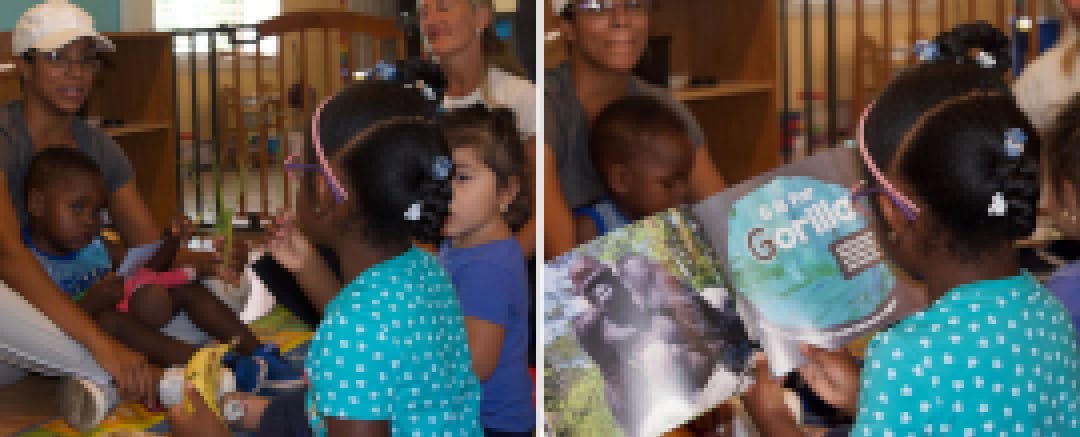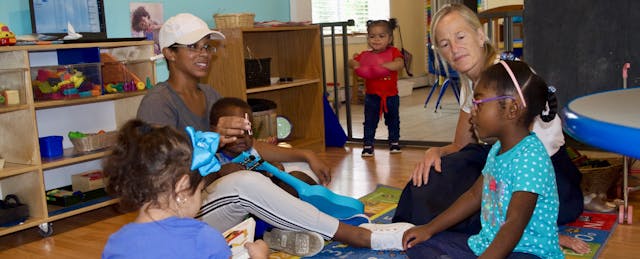BRIDGEPORT, Conn. — Pauline Robinson-Brown will never forget the sound of the front door of her house shutting on her very first day as a family child care provider.
She remembers other things, of course, like which children were in her care: a 7-month-old boy, his 2-year-old sister and her own 2-year-old daughter. But if there’s one detail she is absolutely certain she could never forget, it’s the door.
Robinson-Brown was taking a big risk that day. As she puts it, she was “leaving a cushion”—a steady job she’d held for 10 years at an e-commerce company in New York—“for a question mark”—running a child care program out of her home. And though she’d been preparing for this leap for months—going to workshops, listening to podcasts, meeting with other family child care educators and remodeling her home to accommodate six children between birth and age five—no moment signaled to her that she had turned this whim into a reality like the sound of the door shutting behind the brave mother who’d decided to entrust Robinson-Brown with the two most precious humans in her life.
“That door closed,” Robinson-Brown recalls animatedly, “and I’m like—gasp! ‘The parents are gone! What am I going to do?’”
Robinson-Brown did just fine. She spent the first few months getting her bearings—which meant figuring out how to serve and support three children at three different developmental stages—but for the most part, it was a smooth on-ramp to becoming an educator. The hardest part in those early days, she recalls, was juggling the kids when two of them needed her at once, which they often expressed through explosive fits and crocodile tears. “I used to freak out, inwardly,” Robinson-Brown admits.
Those were the types of scenarios that no amount of training or reading could prepare her for, she says. But in time, she developed a few tricks. One was to transition the kids to separate spaces—a highchair, a playpen, whatever the situation called for. That gave her an opportunity to steal a few seconds of solace and a few deep breaths. Another was to time the tantrums to give herself perspective. A tantrum could feel like forever, but might, in reality, last only one or two minutes.
Fast-forward three years, and Robinson-Brown’s experience shows. On a cloudy day in September, she stands in the middle of the same room those children were dropped off on her very first day and manages, with preternatural ease and patience, two simultaneous tantrums—one from a 2-year-old who’s been in her care since shortly after birth, another from a 15-month-old who only joined her program a week prior. With eyes on the two other children under her supervision that day, Robinson-Brown hoists the baby onto her hip and tends to the toddler at her feet, restoring the room to momentary calm.

It’s the exact kind of situation that, a couple of years ago, left her in a panic. But in time, she’s learned the ropes, often with the help of a local nonprofit called All Our Kin that works with family child care providers to build high quality, sustainable child care businesses. The organization has been an enormous support for Robinson-Brown, who had little exposure or experience as an educator when she decided to switch careers.
In that way, Robinson-Brown is similar to many of the other family child care providers whom All Our Kin supports. The New Haven-based nonprofit, which has been a staple in the community for 20 years, works with providers at every part of their journey, including transitioning from a different career or a stint as a stay-at-home mom to becoming an early childhood educator and business owner.
Robinson-Brown attended All Our Kin workshops and trainings several times before officially opening Laila’s Lighthouse, a program that serves children ages zero to five, most of whom come from low-income families. All Our Kin equipped her with enough basic knowledge and confidence to open her program to the public in September 2016.
One year later, it also brought her Lisa Fay, a longtime early childhood educator who is now an educational coach at All Our Kin. Fay works with about a half-dozen home-based providers at a time, helping them set and fulfill goals, address problems that arise and offer suggestions for improving their instruction. That support has been invaluable to Robinson-Brown, who says, at several points, that “Ms. Lisa is like magic.”
Fay spends about five hours each month at Laila’s Lighthouse, either in the mornings when children are awake, or in the afternoons during nap time, when she and Robinson-Brown can reflect on what worked that day and why. They also tackle big challenges, such as how to tailor the program to serve children from mixed age groups in one setting.
Robinson-Brown, who currently serves a 15-month-old, three 2-year-olds and two 5-year-olds in her program, often wonders how to meet the needs of a group of children spanning such different developmental capabilities.
“Part of what we’re always doing is identifying the strengths of having different ages,” Fay says, adding that it’s one of the most difficult, but also most rewarding, parts of providing home-based care.
Of all the things that are unique about home-based child care programs—the backgrounds of the educators, the small class sizes, the fact that it’s not uncommon for an educator’s child to be in the program, the licensing and accreditation processes—mixed age groupings are perhaps what makes these providers most distinct from early childhood centers. Mixed-aged classrooms offer both benefits and challenges.
In Connecticut, where Robinson-Brown’s program is licensed, home-based providers can have up to six children in their program, two of whom can be under 24 months. So one program could have six children of six different ages at wildly different stages of development.
Supervising those children is one thing—but teaching them, playing with them, cultivating their social-emotional skills and stimulating their brains, all while keeping in mind their varied developmental stages, is another quest entirely.
At first, Robinson-Brown decided that it was enough to keep the children safe, fed and happy while they were in her care. But when Fay came on board two years ago, the pair began differentiating curriculum and implementing strategies that would improve Robinson-Brown’s instruction, allowing her to fulfill the developmental needs of each child.
To meet the demands of mixed ages, Fay says, a successful educator is willing to allow the children freedom of choice. “That means meeting the intellectual and developmental needs of the older ones while being willing to let the younger ones make other choices,” she explains. “It’s a learning curve. Many educators would like everyone to be sitting down” when the class is reading a book or going over a new word together, “but that’s a lot to ask of an 18-month-old.”
Later that day, in Robinson-Brown’s program, this very scenario presented itself. She was introducing the letter “g,” and as part of her lesson, the children would learn all about gorillas. She asked the children to sit down for the lesson, but the youngest child in the program, the 15-month-old girl, was not ready to join the group on the rug. “That’s OK,” Robinson-Brown said.

Later, Robinson-Brown gestures to the artwork covering the walls of the classroom. “You see those two elephants? That day, only two children wanted to do it. That’s OK. See the birds? That day, all the kids wanted to do it.”
Robinson-Brown has also learned to weave extra visual and auditory elements into her lessons to support the younger children, while still challenging the older ones. She illustrated this tactic during the lesson on “g” and gorillas.
Her 5-year-olds know the letter “g” has a “guh” sound, but her younger children do not, so every time Robinson-Brown mentions the gorilla—what it eats, how it moves around, where it sleeps—she adds the extra “guh-guh-guh” in front of the word to help the younger children follow along, pronouncing “guh-guh-guh-gorilla.” Repetition is critical to learning at that young age, she explains.

Other small, seemingly inconsequential details in her lesson are intentional and aid in the children’s learning. After one of the 5-year-olds reads a children’s book about gorillas to the group, Robinson-Brown says she has a surprise: it’s a bag filled with items that start with the letter “g.” One by one, she pulls out a bunch of grapes, a pair of glasses and a plastic Halloween ghost for the children to hold and pass around.
“I just bring in the extra items to emphasize to them, ‘Yes, we're talking about gorillas, but that's the ‘g’ sound and here are some other ‘g’ sounds,’” Robinson-Brown explains. She adds that this activity gives the children an opportunity to practice sharing and using their language, such as “It’s my turn now.”
Natasha Auguste-Williams ran her own family child care program in Bridgeport for about eight years before joining All Our Kin last winter as a community specialist and mentor. Auguste-Williams says that, like Robinson-Brown, she would have all the children in her care participate in the same activities and add in extra sensory elements depending on their ages. If she had infants, she might have the older children build and play while the babies slept in a sequestered part of the room, but otherwise, she read to everyone—babies, toddlers, preschoolers—and taught everyone the same lessons.
During circle time, the older kids know answers the younger ones have not yet arrived at, and educators still want the younger kids to get there on their own. Auguste-Williams liked to handle this using a makeshift talking stick—only the child holding the designated ball got to answer the questions.
She says she would prepare the older kids first. “I would tell them, ‘We’re going to talk about water, and I know you know so much about water. I am so proud of you for that, super proud. But I want to know how much Tom knows, too. What do you think if we give him a turn to let us know?’”
In these ways, Fay says, the older children may be learning just as much from their younger counterparts as the younger kids learn from older ones.
And, she adds, since many home-based programs enroll infants who sometimes stay until kindergarten, the classroom becomes a family and the children function like siblings. They argue and pick on each other, sure, but they also learn to share and how to be gentle with the younger ones and love one another.
“Because they’re with each other for such a long time each day,” Fay says, “they’re really working out a lot of family dynamics. They need to learn to work together in a tight community.”


